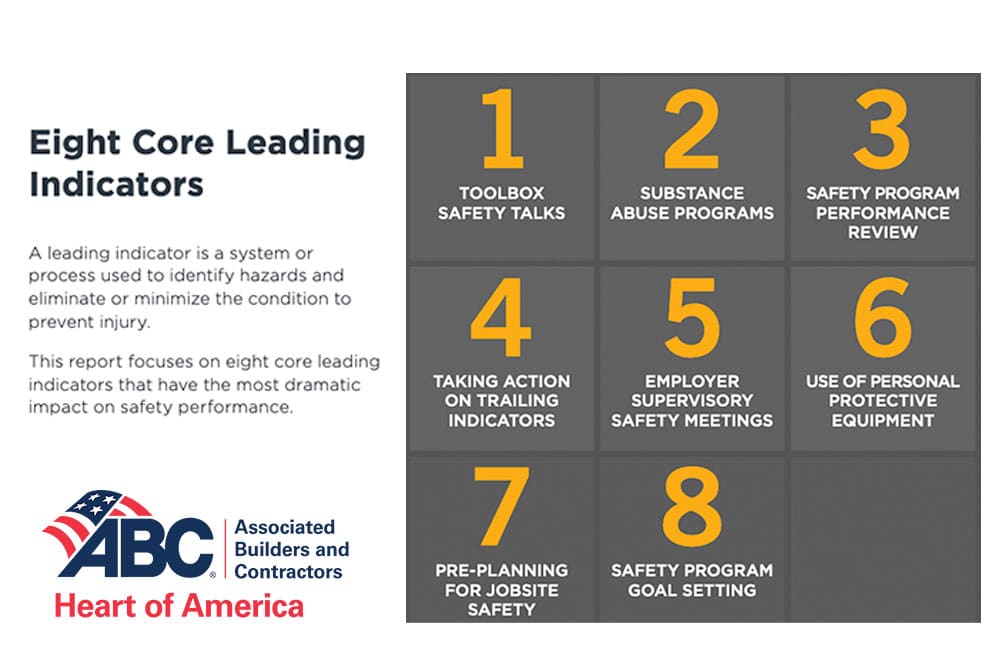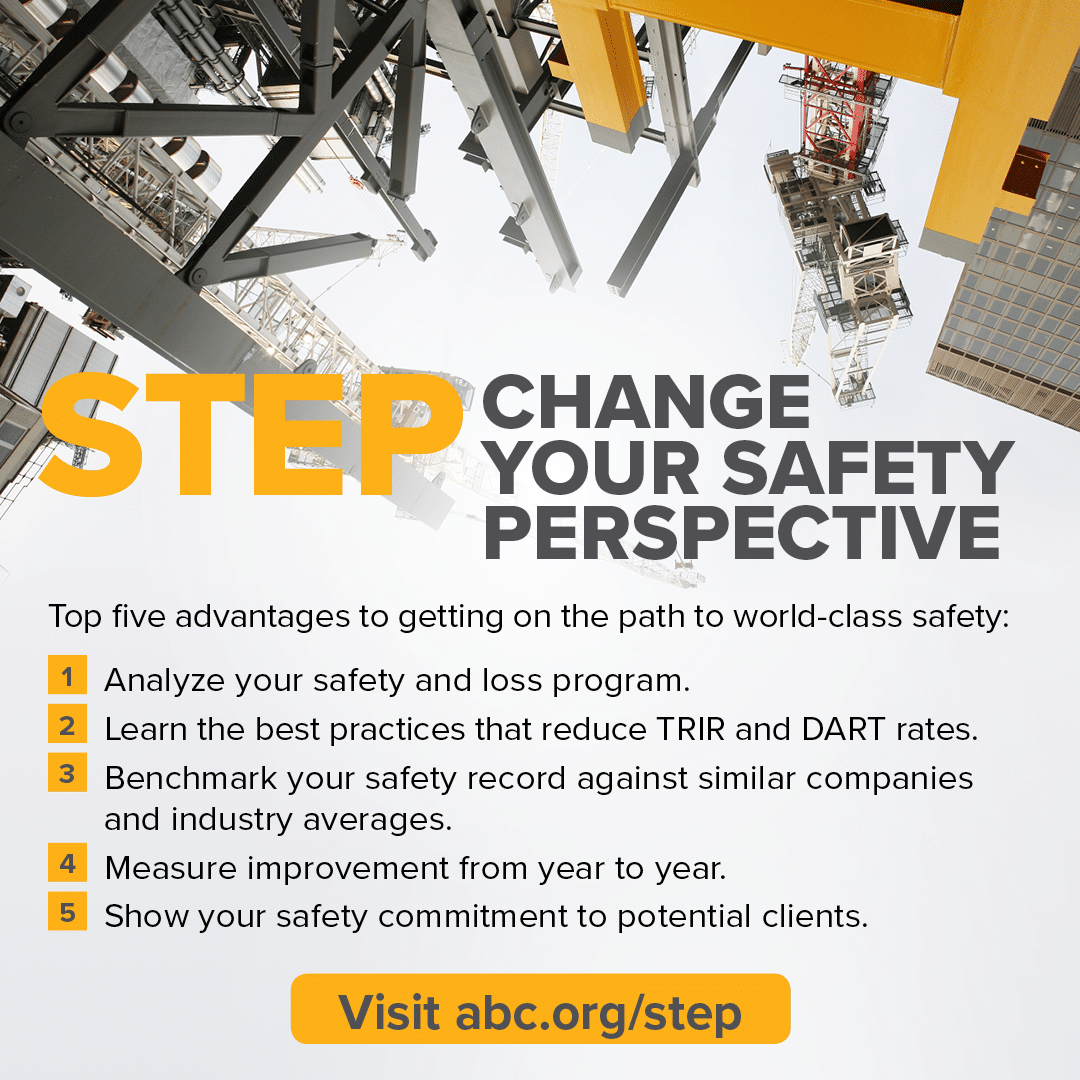What if your company could be 655% safer than the industry average? ABC’s STEP tool…
2019 Safety Performance Report: Key Indicators

Today, professionals within the construction industry have more data than ever before to help accurately capture root causes and trends to impact safety performance. In an industry such as construction, safety is the first priority of all employees and job-site supervisors. Associated Builders and Contractors provides the industry with three tools to help create better job-site conditions for everyone to complete their work safely and go home to enjoy time with their loved ones every day.
These tools include:
- STEP: A world-class safety management system improved annually by the ABC National Safety and Health Committee. Click here to learn more about the ABC STEP Safety Management System.
- The annual ABC Safety Performance Report to analyze the cause-and-effect relationship between best-in-class processes and incident prevention.
- ABC’s Safety Academy to help construction companies lay out a multi-year plan to achieve industry-leading safety results.
Improving your organization’s safety performance starts with several indicators that can be closely monitored and measured to better understand where your initiatives will have the most impact on the job-site.
Using Key Indicators to Create Safer Job Sites
Until now, very few studies have been conducted on the correlation between the use of safety measures that companies can take to keep workers safe on job-sites – leading indicators and the number of incidents, accidents, and injuries that occur—trailing indicators. ABC created the Safety Performance Report to address this issue so that workers can return home in the same condition in which they arrived. The 2019 ABC Safety Performance Report is based on submissions of 35 company data points gathered from members that deployed the STEP Safety Management System in 2018.
Founded in 1989, STEP is a world-class safety management system. It was created as a benchmarking and improvement tool. STEP allows participating ABC member firms to measure their safety processes and policies on key components with the goal of implementing or enhancing safety programs that improve job-site safety and reduce incidents.
Any current ABC member firm that wants to improve their company’s safety performance is welcome to apply for STEP. Commercial and industrial contractors, as well as supplier members, are among those who qualify. Keep reading to find out how to submit your STEP application at the end of this post.
A Quick Overview of Trailing Indicators
The construction industry has long been evaluated for its safety performance based on trailing indicators—statistics that measure performance based on past incidents or conditions. These statistics judge companies not on the steps taken to prevent job-site injuries and fatalities, but rather on the number of past safety failures. We believe that safety performance shouldn’t be reflected in what you’ve done in the past, but what you’re doing to prevent incidents in the future.
Trailing indicators include:
- Total Recordable Incident Rate (TRIR)
- Days Away, Restricted or Transferred Rate (DART)
- Experience Modification Rate (EMR)
The Eight Core Leading Indicators of Job-Site Safety
A leading indicator is used to identify hazards and eliminate or minimize the condition to prevent potential injury. The 2019 ABC Safety Performance Report focuses on eight core leading indicators that have the most dramatic impact on safety performance.
1. Toolbox Safety Talks
At ABC, we don’t think it’s possible to talk about safety too much which is why our
first leading indicator involves having a toolbox safety talk at the beginning of every day with all onsite employees.
Shelley Sutton, vice president of shared services, hth companies inc. and ABC Accredited Quality Contractor has implemented toolbox safety talks into her company’s daily routine and says, “Starting each day with a toolbox safety talk not only reinforces those general safe work expectations and obligations but more importantly, demonstrates to the workforce the importance of putting safety first each and every day.”
These meetings only have to be around 15-30 minutes in length and can be about one particular safety topic. Companies that conduct daily toolbox talks reduce their TRIR by 85 percent compared to companies that hold them less regularly.
2. Substance Abuse Programs
One-third of all incidents that occur on construction job-sites are drug- or alcohol-related. Companies with substance abuse policies and programs that include provisions for drug and alcohol testing where permitted are 60 percent safer than those without a program. Substance abuse testing, including drug and alcohol testing pre-hire, randomly, and with reasonable suspicion can be an effective method of incident prevention if used properly and a safety policy with strict rules regarding drug and alcohol use, supervisor training, record-keeping, and active enforcement can help provide all employees with assistance and education on substance abuse prevention.
3. Safety Program Performance Review
A biannual review of safety program performance that evaluates whether the effectiveness of a program and whether or not the expected results identify opportunities for improvement leads to a 59 percent reduction in TRIR and a 60 percent reduction in DART rates.
Safety performance is measured against defined criteria and provides all employees with the opportunity to find improvement through the use of incident rates, survey results, and other various methods. The results of these reviews and expectations are to then be discussed with all employees, supervisors, executive leadership members and can drastically impact safety staff and supervisor performance evaluations.
4. Taking Action on Trailing Indicators
Regularly reviewing claims, claim costs and claim trends to gauge the impact on the company and training your personnel to understand the meaning and relevance of these key safety rates and numbers such as EMR, TRIR, and DART leads to a 57 percent reduction in TRIR and a 62 percent reduction in DART rates. EMR is below 0.8 for the current and previous year for companies with 100 or more employees (0.9 for companies with fewer than 100 employees)
5. Employer Supervisory Safety Meetings
By conducting weekly safety meetings with supervisors and setting aside an allotted amount of time for review leads to a 56 percent reduction in TRIR and a 59 percent reduction in DART rates. These weekly safety meetings include status reports on current job-site safety activities, as well as pre-planning discussions, review of prior job-site activities, and a review of any serious incidents that have occurred.
6. Use of Personal Protective Equipment
Having a written PPE policy that is consistently and universally enforced throughout the workplace leads to a 55 percent reduction in TRIR and DART rates. Your PPE should also include an annual needs assessment and be leveraged to continually invest in new workplace equipment.
Field personnel should regularly evaluate the sustainability and effectiveness of PPE and employees should also be annually trained and educated on PPE requirements for each job, as well as PPE selection, inspection, use, and care.
7. Pre-planning for Job-Site Safety
Bringing safety pre-planning into all phases of a construction project (estimating, bid, and pre-mobilization) leads to a 53 percent reduction in TRIR and a 54 percent reduction in DART rates.
Pre-planning is used to communicate to all site employees before implementation and should be regularly updated throughout the life of the project. Supervisors and key personnel should also be trained in pre-planning for safety measures and checklists.
8. Safety Program Goal Setting
Action plans are developed, documented, communicated, and implemented so that progress can be tracked and reported, allowing feedback to be solicited. Implementing a formal process to annually assess safety program needs and establish safety goals leads to a 48 percent reduction in TRIR and a 50 percent reduction in DART rates. These action plans should be evaluated for effectiveness in achieving end goals and supervisors and executive leadership members should collaborate with one another to review goals, plans, and reports to provide direction for all employees.
Start Measuring Your Safety Culture
Safety culture and performance are critical to the success of the construction industry as a whole. The time to implement this data is now so that you can work closely with all of your employees to define a safety culture index to enhance your workplace safety performance.
You still have time to submit your application for this year! ABC Heart of America’s STEP deadline has been extended to Wednesday, July 31. Companies wanting to apply can do so here. If you require any additional assistance, please call our office at 816-994-5990 to speak with our Training Manager, Aubry Cottrel.
Click here to view the entire 2019 Safety Performance Report.
Note: All figures within this piece of content can be directly sourced to ABC’s 2019 Safety Performance Report and STEP Program Statistics



